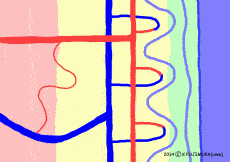[045] Arteriovenous anastomoses in skin (GB#103B05) | 基礎医学教育研究会(KIKKEN)Lab

● The heart is warm in people with cold hands
When I was a child, a few friends were saying something like this. Actually, even in English, it says, there is an old proverb of “Cold hands, warm heart.” Is it common in the world, at least, to separate people with cold hands and those with warm hands? The difference in hand temperature, that is, the difference in body heat dissipation. When the hands are cold it means that there is little heat dissipation from the hands, so that the heat gets buried inside the body, maybe the “heart” is also warm?
—
Contents
- 1 ● Heat comes in blood
- 2 ● The body is wrapped in subcutaneous fat
- 3 ● There is a blood vessel rich dermis on the outer side of adipose tissue
- 4 ● While keeping warm to some extent, regulate heat release
- 5 ● Special adjustment devices are in hand
- 6 ● Arteriovenous anastomosis flush a large amount of blood
- 7 ● Arteriovenous anastomosis opens even when cold?
- 8 ●Is the arteriovenous anastomosis of the skin effective?
- 9 ● If you take out heat from your hands, will your body cool?
- 10 ● Is there a difference in the temperature of hands by humans?
- 11 ● Do people with cold hands tend to take warm actions?
- 12 ○ Referenced sites
- 13 ○ Related articles
- 14 ○ Referenced books
● Heat comes in blood
Even a warm hand does not produce that heat in the palm of the hand. The main source of heat is the internal organs of the body which is constantly and actively metabolizing. Heat produced there heats the blood, it is carried to the end of the body through the blood, and finally it is dissipated from the surface of the body, out of the skin, while maintaining the body temperature of each place. Even with cold hand people, the mechanism is not different. Heat is dissipated from the skin of the whole body, but those with cold hands at least have less heat dissipated from the palm than the person with warm hands.
● The body is wrapped in subcutaneous fat
Roughly speaking, the skin consists of epidermis, dermis and subcutaneous tissue from the outermost side. The blood vessels are running to the dermis, and the epidermis has no blood vessels. Frequently talked about, “subcutaneous fat” is “adipose tissue” accumulated in subcutaneous tissue. Perhaps from the meaning “under the skin”, it may not be included in “skin”, but there is no clear boundary layer between the dermis and subcutaneous tissue, and the adipose tissue is always underneath the dermis all the time. Although the epidermis and dermis total no more than 2 mm in thickness, subcutaneous tissue is many times that number. Although there are considerable differences depending on the location, most of the thickness thought that this is the skin by pinching with the finger should actually be due to the subcutaneous tissue.
● There is a blood vessel rich dermis on the outer side of adipose tissue
Subcutaneous fat is said to have a high adiabatic effect. Actually, it seems that the conductivity is at most one half of that of water of the same thickness, so it is not so high insulation effect. Even so, if you thicken the layer of fat, there will be less heat transfer than a thin layer of water-rich cells, and to some extent will act as a thermal insulator. Therefore, once the human body is wrapped in a soft heat preservative, the whole body is made.  It is like wrapping up the sweet potatoes with dried newspaper in Japan. However, in the human body, the blood vessels penetrate the heat retention agent, and outside of it again, a dermal layer rich in blood vessels is made. There are no blood vessels in the outer layer of the dermis so as not to bleed easily, but the cells of the epidermis proliferate actively and must be replaced, so that the abundance of blood vessels is indispensable just below the epidermis.
It is like wrapping up the sweet potatoes with dried newspaper in Japan. However, in the human body, the blood vessels penetrate the heat retention agent, and outside of it again, a dermal layer rich in blood vessels is made. There are no blood vessels in the outer layer of the dermis so as not to bleed easily, but the cells of the epidermis proliferate actively and must be replaced, so that the abundance of blood vessels is indispensable just below the epidermis.
● While keeping warm to some extent, regulate heat release
Since blood vessels of the skin spread out of the heat retardant, blood circulating the dermis can easily dissipate heat to the surface of the skin unlike when it is under the heat retardant. In other words, the skin has a dual structure consisting of an inner layer that is hard to dissipate heat and a surface layer that is easy to escape. This is an important point of the skin’s work on regulating body temperature.
With this structure, as the amount of blood circulating in the skin increases, more heat escapes outside the body, and as the amount of blood decreases, the role of a heat retardant acts to make it difficult for heat to escape from the body. Skin blood vessels actually expand when the inside of the body gets hot and need to escape the heat, and the blood flow becomes many times more. On the contrary, when it is cold and you have to keep your body temperature, in extreme cases, at least the blood flow in the surface layer will decrease to a point where it stops. Tissue thermal conductivity also varies with temperature. As the temperature decreases, the thermal conductivity of water-rich tissues increases, while the thermal conductivity of fat seems to be low. Therefore, the role of subcutaneous fat to the heat retention effect further increases.
Conversely, it is also known that when the temperature outside the body is high and the surface temperature of the skin becomes higher than the body temperature, skin blood vessels contract to suppress blood flow. It is a natural reaction if it is a purpose to keep the temperature inside the body normal.
● Special adjustment devices are in hand
The most important function of blood vessels is to bring fresh blood, arterial blood to the capillaries of the tissues of every corner of the body and to recover what the tissue throws away from there instead. So it is the principle that the flow of blood vessels is followed by arteries ⇒ capillaries ⇒ veins. But in some parts of the body, especially the palms and fingers, the soles and fingers of the feet, the lips and cheeks, ears, etc., there are many direct connections of the arteries and veins that jumped capillaries in the dermis of the skin. This direct connections is called “arteriovenous anastomosis” of the skin.  Since it is a long word in English, it is often written with “AVA”, an abbreviation that is too simple and meaningless to grasp. Actually, there seems to be plenty still unclear parts, but skin AVA is regarded as a special device to regulate the dissipation of heat, which is also introduced in textbooks. However, it is too easy to explain, so usually you do not understand the meaning well.
Since it is a long word in English, it is often written with “AVA”, an abbreviation that is too simple and meaningless to grasp. Actually, there seems to be plenty still unclear parts, but skin AVA is regarded as a special device to regulate the dissipation of heat, which is also introduced in textbooks. However, it is too easy to explain, so usually you do not understand the meaning well.
● Arteriovenous anastomosis flush a large amount of blood
Peripheral blood vessels leading to capillaries basically undergo innervation of the sympathetic nerve. When the nerve activity is high, the smooth muscle of the blood vessel contracts to suppress the blood flow, and conversely, when relaxing the blood vessel suppresses the nerve activity. The arteriovenous anastomosis of the skin is mostly in the deep layer of the dermis, the smooth muscle surrounds it much more thickly than other surrounding blood vessels, and the innervation of the sympathetic nerve is also specially abundant. Especially if it is not hot or cold, this arteriovenous anastomosis seems to be closed. At that time, the blood normally circulates through the capillaries of the layer closer to the epidermis.
When it gets to rise in body temperature and become necessary to dissipate heat outside, sympathetic activity controlling this blood vessel is suppressed and arteriovenous anastomosis opens. As the whole blood vessel expands, the blood flow of the capillary vessel also increases, but blood passing through the arteriovenous anastomosis does not go to the capillary blood vessel, but only heat is discharged and it flows immediately into the vein. The arteriovenous anastomosis is said to be capable of flowing blood up to 200 times or 500 times the amount flowing through the capillary.
● Arteriovenous anastomosis opens even when cold?
 When exposed to a cold environment the blood vessels of the skin contract to reduce blood flow. It is to prevent the heat in the body from escaping. However, suppression of the circulation of the skin is a severe way of life and death for cells of the skin, while heat is difficult to escape.Since the metabolism of the cells falls at low temperature, it becomes strong against ischemic condition. But prolonging it is still a disadvantage. In such a case, depending on the part of the body, blood vessels of the skin sometimes open arbitrarily and resume blood flow temporarily.
When exposed to a cold environment the blood vessels of the skin contract to reduce blood flow. It is to prevent the heat in the body from escaping. However, suppression of the circulation of the skin is a severe way of life and death for cells of the skin, while heat is difficult to escape.Since the metabolism of the cells falls at low temperature, it becomes strong against ischemic condition. But prolonging it is still a disadvantage. In such a case, depending on the part of the body, blood vessels of the skin sometimes open arbitrarily and resume blood flow temporarily.
If the temperature is low enough to stop the circulation, excitatory conduction of the nerve fibers is also blocked, so the effect of the sympathetic nerve that closed the blood vessel disappears, and whether the smooth muscle relaxes arbitrarily. It seems that when the blood flow resumes, the temperature of the tissue rises, when the nerve activity revives, the blood vessels contract, the circulation is suppressed, and the tissue cools again. (Actually it does not go well, it gets burned or frostbite.)
●Is the arteriovenous anastomosis of the skin effective?
Arteriovenous anastomosis is thought to be strongly related to temperature regulation, but its place has not spread throughout the body. There seems to be almost no AVA in a place that hides in the wet suit of diving.To be more precise, if you think about the body of the monkey, it is not in a place covered with hair, it is confined to a narrow place without body hair. Even if it is on the skin where the hair is covered tightly, it can not expect much heat dissipation effect, so it will be good. Originally other than humans, sweat glands are not in the part with body hair. Although the sweat glands spread throughout the body in humans, the arteriovenous anastomosis is like taking over the ancestral distribution almost as it is. How does human’s arteriovenous anastomosis of hand have meaning in thermoregulation? Calculating roughly the effect of the area, the area of both hands is about 300 cm2 in total, while the body surface area of the whole body is about 16000 cm2. There is only about 2% influence. Apparently, for people, it seems more important that “the effect of warming the hand” is more important.
● If you take out heat from your hands, will your body cool?
Even though the arteriovenous anastomosis of the hand works the maximum, the hand will warm but the body temperature does not seem to drop as much as we thought. The palms and soles of the feet are described in physiology textbooks as places where “thermal sweating” does not occur. Sweating in your hands is a phenomenon when you feel dizzy, such as shaking. This is mental sweating. So even if your body temperature rises and heat is transferred to the skin of the hand, there is no sweat, so the hand will get hot, but not much heat will escape. It is natural that air is much more adiabatic than fat.
However, for example, when you immerse your hands wrapped in running water it will be completely different. The excess heat will steadily conduct and escape to the water that touched the skin. If you accidentally immerse your hand in ice water, physiological reactions such as vasoconstriction will occur and impede heat dissipation, so water that is not too cold is an important. In the university of the United States, using this effect, a device for rapidly cooling the whole body temperature with only one hand has been developed and commercialized. Perhaps, most of the time, hands are being thrown into the air is a human being, other ordinary animals are always wearing forelimbs and hind legs on the ground, or living with something grabbing, there is no doubt that the adjustment of the heat dissipation in the skin works much more effectively.
● Is there a difference in the temperature of hands by humans?
When examining around us, it was true that some people with hands are warm, some have cold hands. The warm group is roughly 33 °C to 34 °C, the cold group is around 27 °C to 28 °C, and the two groups are not consecutive (Room temperature 23 °C, using AS ONE infrared radiation thermometer ISK-8700ii). Because there is a difference of 5 °C, from the warmest hand it feels like the lower temperature hand is clearly cold. The number of people was more warm, at least it seemed like a minority of cold hands around me, but unfortunately it was impossible to judge whether the hearts of these people were warm at ISK-8700. For myself, the temperature of the hands sometimes falls to about 30 °C for no reason, but at about 33 °C it enters a group of warm hands. Even though there are people with hypothermia, body temperature is not different by 5 °C. So, if your hands are warm, the blood vessels of your skin tend to loosen on average, and that your hands are cold means that it will be narrowed on average. Whether the hands are warm or cold, but the body temperature is about the same, the hands are always warm may seem to dissipate a little wasteful energy.
● Do people with cold hands tend to take warm actions?
A while ago in the American science magazine, the result of a certain psychological experiment was becoming a topic. Roughly summarizing the experiment itself,When touching a warm thing with a hand, it is easy to judge a person in front of you as a warm person unconsciously, and if you choose something to receive at that time, the tendency to choose for friends rather than for themselves is there. On the other hand, when touching a cold thing, it is the reverse, and it tends to make selfish judgment unconsciously. This report is quoted in several other magazines and so forth. There, psychologically, if you touch a person with a cold hand, you do not have a good feeling for that person. Therefore, it seems that the phrase “Cold hands, warm heart” to be interpreted as something like the wisdom of social life which dares to cancel it.
Although the original authors who reported the experiments did not mention this legend at all, it would be unnecessary care, what we can say honestly from this report is that “People will do warm actions to others if they have a warm experience.” People with cold hands often have opportunities to touch warm people and warm objects than hands compared to warm people. Does that mean that the people are more likely to take a warm act warmly? Then, as a result, “The person with cold hands is warm hearted” . . That’s it!
○ Referenced sites
・Arterio-Venous Anastomoses and Thermoregulation (1991)(pdf)
・The Anatomy and Histochemistry of the Arteriovenous Anastomosis in Human Digital Skin.(1956) (pdf)
・食品の熱伝導度,(リンク元削除,2017-7-4) ⇒ 食品科学便覧,共立出版(株),食品科学便覧編集委員会編参照
・加熱調理と熱物性,杉山久仁子,日本調理科学会誌,2013.(pdf)
・AVAcore Technologies and CoreControl.
・Experiencing Physical Warmth Promotes Interpersonal Warmth, Williams and Bargh, SCIENCE, 2008.
・A More Social Explanation of “Cold Hands, Warm Heart”, Krystal D’Costa, Scientific American, 2012.
・気温 38℃は暑いのに,38℃のお風呂はなぜ熱くないのか, 自然科学コンクール第43回入賞作品中学校の部文部科学大臣奨励賞,2002. 。
・同じ 33℃で気温は暑く水温は冷たいのはなぜ, 日常の化学工学, 化学工学資料のページ
・日本人の体表面積, 暴露係数ハンドブック, 独立行政法人産業技術総合研究所.(pdf)
○ Related articles
◆[038] 深部体温の恒常性 homeostasis of the core body temperature ![]()
◆[048] Epidermal cell turnover ![]()
◆[025] 血管の運動 vasomotor ![]()
◆[033] 平滑筋の収縮 smooth muscle contraction ![]()
◆[016] 血液循環 blood circulation ![]()
◆[001] Heartbeat pumping ![]()
○ Referenced books
・カラー版 ボロン ブールペープ 「生理学」, 西村書店
・カラー図解 人体の正常構造と機能 全10巻縮刷版,坂井 建雄,日本医事新報社
・トートラ人体解剖生理学 原書8版,丸善
・柔道整復学校協会編「生理学」,南江堂
・東洋療法学校協会編「生理学」,医歯薬出版株式会社
rev.20141119,rev.20141211,rev.20160422,rev.20170506, rev.20170716, rev.20170921, rev.20171025, rev.20180304.
KISO-IGAKU-KYOIKU-KENKYUKAI(KIKKEN)








コメント
Dear Louise Tremblay
Thank you for your enquiry.
Thank you for your interest in our illustrations.
If you only want to extract a small number of images without modification, you can use them by stating the source as follows.
KIKKENLab(2022),https://gozasso.com/kikkenlab/. or (KIKKENLab, 2022).
You can download the illustrations from the internet and use them, but if you would like a higher quality image for printing, send the sample image you would like to use to this address and we will accommodate you.
When the book is finished, we would be grateful if you could send us a copy of the relevant page.
Hello,
I’m writing a book for manual therapists “physiological pillars of manual therapy” and I would like to use your arteriovenous image (the last one AVA opens in cold). Not as a video, only the image. Please tell me how to proceed.
Thank you